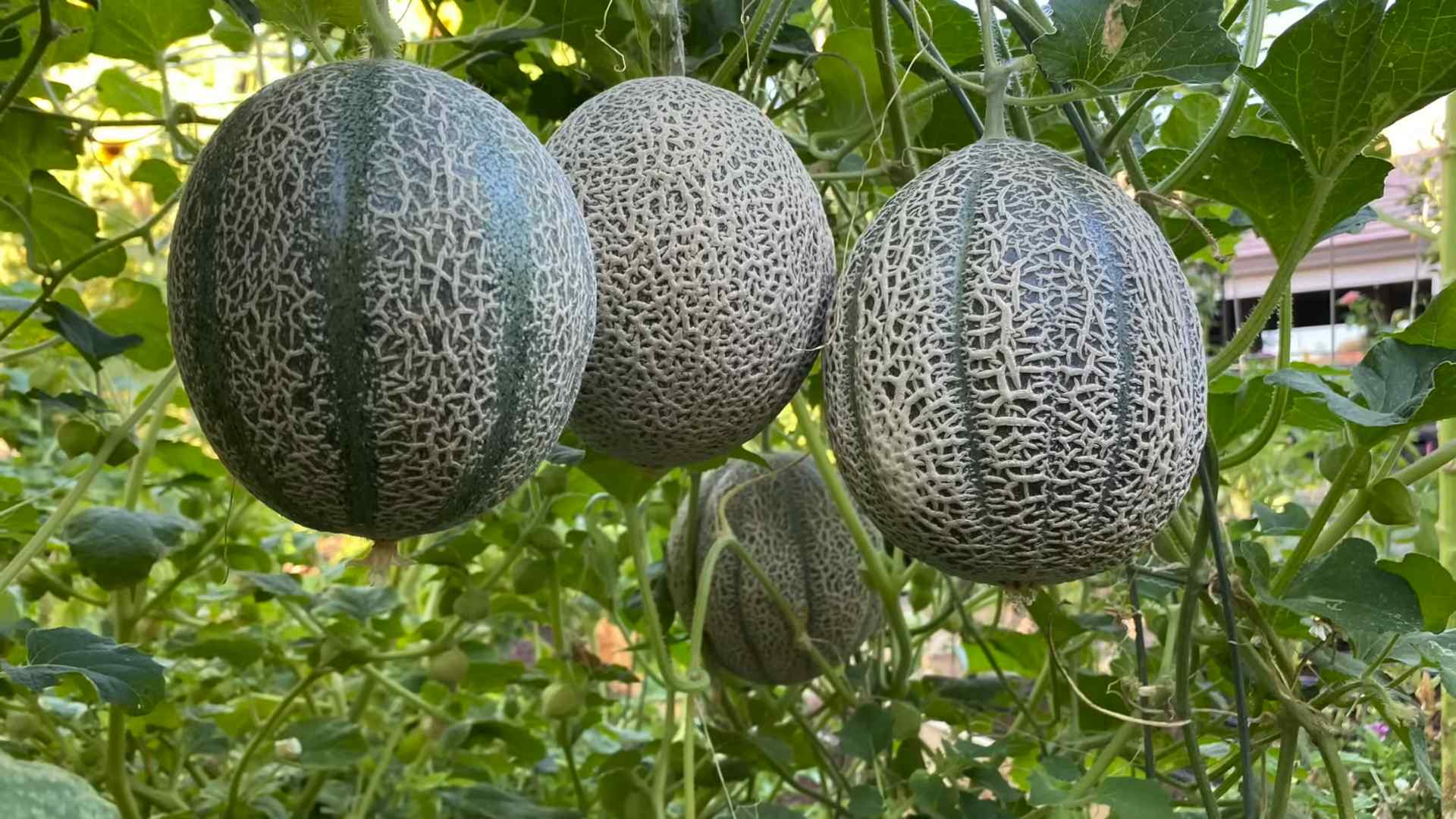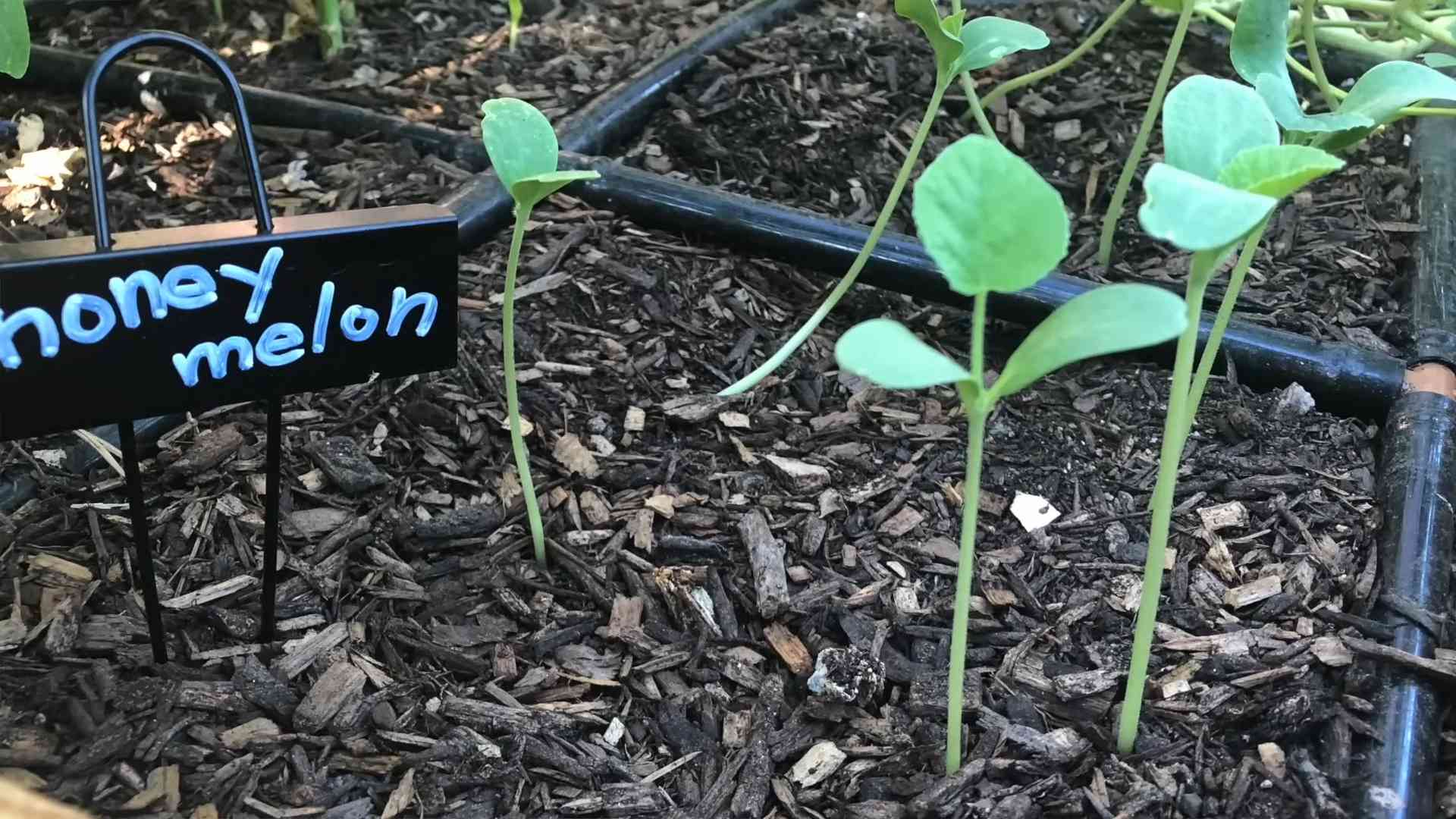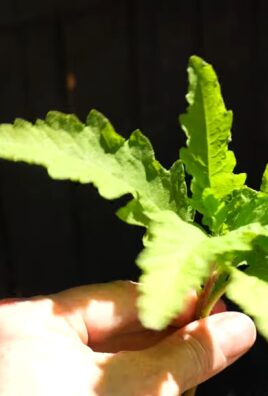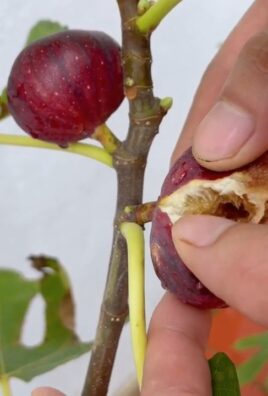Grow Cantaloupe at Home? Absolutely! Imagine biting into a juicy, sun-ripened cantaloupe that you nurtured from seed to fruit, right in your own backyard. Forget those bland, store-bought melons – we’re talking about flavor explosions here! For centuries, cantaloupe has been a symbol of summer sweetness, enjoyed across cultures from ancient Egypt to modern-day picnics. But did you know that cultivating this delicious fruit is easier than you might think?
I know what you’re thinking: “I don’t have a green thumb!” But trust me, with a few simple tricks and DIY hacks, you can successfully grow cantaloupe at home, even if you’re a beginner gardener. This article is your ultimate guide to unlocking the secrets of cantaloupe cultivation. We’ll cover everything from seed starting to pest control, ensuring you have a bountiful harvest. Why spend money on expensive, often tasteless, melons when you can enjoy the unparalleled flavor of homegrown cantaloupe? Plus, there’s nothing quite as satisfying as sharing your homegrown bounty with friends and family. Let’s get started and transform your garden into a cantaloupe paradise!

Grow Delicious Cantaloupe in Your Own Backyard!
Hey there, fellow gardening enthusiasts! I’m so excited to share my tried-and-true method for growing juicy, sweet cantaloupe right in your own backyard. Forget those bland, store-bought melons – nothing beats the flavor of a homegrown cantaloupe, ripened to perfection under the summer sun. This guide will walk you through every step, from seed to harvest, ensuring you have a bountiful cantaloupe crop. Let’s get started!
Choosing the Right Cantaloupe Variety
Before we dive into the nitty-gritty, let’s talk about choosing the right cantaloupe variety for your garden. Different varieties have different characteristics, such as size, sweetness, disease resistance, and days to maturity. Here are a few of my favorites:
* ‘Hales Best Jumbo’: A classic choice, known for its reliable yields and delicious flavor. It matures in about 85 days.
* ‘Athena’: A popular hybrid variety that’s resistant to powdery mildew and other common cantaloupe diseases. It matures in around 75 days.
* ‘Ambrosia’: This variety is prized for its exceptionally sweet and aromatic flesh. It matures in about 86 days.
* ‘Minnesota Midget’: If you have limited space, this is the perfect choice! It produces small, personal-sized cantaloupes on compact vines. It matures in about 60-70 days.
Consider your local climate and growing season when making your selection. Check seed packets or online resources for specific recommendations for your region.
Preparing Your Garden Bed
Cantaloupes are sun-loving, heat-loving plants, so choosing the right location is crucial. They also need well-drained soil that’s rich in organic matter.
* Sunlight: Cantaloupes need at least 6-8 hours of direct sunlight per day. Choose a spot in your garden that gets plenty of sunshine throughout the day.
* Soil: Cantaloupes thrive in well-drained soil with a pH between 6.0 and 6.8. If your soil is heavy clay or sandy, amend it with plenty of compost or other organic matter to improve drainage and fertility.
* Space: Cantaloupe vines can spread quite a bit, so give them plenty of room to grow. Allow at least 2-3 feet between plants and 4-6 feet between rows. If you’re growing a bush variety, you can space them closer together.
Step-by-Step Soil Preparation
1. Clear the area: Remove any weeds, rocks, or debris from the planting area.
2. Amend the soil: Spread a 2-3 inch layer of compost or well-rotted manure over the soil surface.
3. Till or dig: Use a garden fork or tiller to incorporate the compost into the soil to a depth of 6-8 inches.
4. Smooth the surface: Rake the soil smooth and level.
5. Consider raised beds: If your soil is poorly drained, consider planting your cantaloupes in raised beds. This will improve drainage and warm the soil more quickly in the spring.
Starting Cantaloupe Seeds
You can either start cantaloupe seeds indoors or direct sow them in your garden. Starting seeds indoors gives you a head start on the growing season, especially in cooler climates.
* Starting Indoors: Start seeds indoors about 3-4 weeks before the last expected frost.
* Direct Sowing: Direct sow seeds in your garden after the soil has warmed to at least 65°F (18°C).
Starting Seeds Indoors: A Detailed Guide
1. Gather your supplies: You’ll need seed starting trays or pots, seed starting mix, cantaloupe seeds, a spray bottle, and a heat mat (optional).
2. Fill the trays or pots: Fill the seed starting trays or pots with seed starting mix. Gently firm the mix down.
3. Sow the seeds: Plant 2-3 seeds per cell or pot, about 1/2 inch deep.
4. Water gently: Use a spray bottle to moisten the soil. Avoid overwatering, which can lead to damping off.
5. Provide warmth: Place the trays or pots on a heat mat to maintain a soil temperature of 75-85°F (24-29°C). This will help the seeds germinate quickly.
6. Provide light: Once the seeds germinate, remove them from the heat mat and place them under grow lights or in a sunny window.
7. Thin the seedlings: Once the seedlings have developed their first true leaves, thin them to one plant per cell or pot. Choose the strongest, healthiest seedling and snip off the others at the soil line.
8. Harden off the seedlings: Before transplanting the seedlings into your garden, you’ll need to harden them off. This means gradually exposing them to outdoor conditions over a period of 7-10 days. Start by placing the seedlings in a sheltered location for a few hours each day, gradually increasing the amount of time they spend outdoors.
Direct Sowing Cantaloupe Seeds: A Simple Approach
1. Prepare the soil: Make sure the soil is warm and well-drained.
2. Sow the seeds: Plant the seeds about 1 inch deep and 2-3 feet apart.
3. Water gently: Water the soil gently after planting.
4. Thin the seedlings: Once the seedlings emerge, thin them to one plant per hill.
Transplanting Cantaloupe Seedlings
Once the danger of frost has passed and the soil has warmed to at least 65°F (18°C), it’s time to transplant your cantaloupe seedlings into the garden.
1. Choose a cloudy day: Transplanting on a cloudy day will help reduce stress on the seedlings.
2. Dig the holes: Dig holes that are slightly larger than the root balls of the seedlings.
3. Remove the seedlings from their containers: Gently remove the seedlings from their containers, being careful not to damage the roots.
4. Place the seedlings in the holes: Place the seedlings in the holes and backfill with soil.
5. Water thoroughly: Water the seedlings thoroughly after transplanting.
6. Mulch: Apply a layer of mulch around the plants to help retain moisture and suppress weeds. I like to use straw or shredded leaves.
Caring for Your Cantaloupe Plants
Cantaloupes need consistent care to thrive. Here’s what you need to do:
* Watering: Water your cantaloupe plants regularly, especially during dry periods. Aim to keep the soil consistently moist, but not waterlogged. Water deeply at the base of the plants, avoiding wetting the foliage, which can promote disease.
* Fertilizing: Cantaloupes are heavy feeders, so fertilize them regularly with a balanced fertilizer. I like to use a fertilizer that’s high in phosphorus and potassium, which promotes fruit development. Follow the instructions on the fertilizer label.
* Weeding: Keep the garden bed free of weeds, which can compete with the cantaloupe plants for nutrients and water. Hand-pull weeds regularly or use a hoe to cultivate the soil.
* Pest and Disease Control: Keep an eye out for common cantaloupe pests and diseases, such as aphids, squash bugs, and powdery mildew. Treat infestations promptly with insecticidal soap or neem oil. Prevent powdery mildew by providing good air circulation and avoiding overhead watering.
* Pollination: Cantaloupes require pollination to set fruit. If you’re not seeing many bees in your garden, you may need to hand-pollinate the flowers. To hand-pollinate, use a small paintbrush to transfer pollen from the male flowers to the female flowers. Male flowers have a long, thin stem, while female flowers have a small fruit at the base.
Training and Pruning Cantaloupe Vines (Optional)
While not essential, training and pruning cantaloupe vines can improve air circulation, reduce disease, and promote larger fruit.
* Training: You can train cantaloupe vines to grow up a trellis or fence. This will save space in your garden and improve air circulation.
* Pruning: Prune away any dead, diseased, or overcrowded vines. You can also prune away some of the lateral vines to encourage the plant to focus its energy on producing fewer, larger fruits.
Harvesting Your Cantaloupe
Harvesting cantaloupe at the right time is crucial for getting the best flavor. Here’s how to tell when your cantaloupes are ripe:
* Color: The skin of the cantaloupe will turn from green to tan or yellow.
* Aroma: The cantaloupe will have a sweet, musky aroma.
* Stem:

Conclusion
So, there you have it! Growing cantaloupe at home, while it might seem daunting at first, is an incredibly rewarding experience. It’s a chance to connect with nature, nurture something from seed to fruit, and ultimately, enjoy the unparalleled flavor of a homegrown cantaloupe. Forget the bland, often tasteless melons you find at the grocery store. Imagine sinking your teeth into a juicy, sun-ripened cantaloupe, bursting with sweetness and aroma – a flavor that only comes from the care and attention you provide.
This DIY trick, focusing on [mention a specific trick discussed in the article, e.g., vertical gardening for cantaloupe or using coffee grounds as fertilizer], is a game-changer for several reasons. First, it maximizes space, making it possible to grow cantaloupe even in smaller gardens or on balconies. Second, it improves air circulation, reducing the risk of fungal diseases that can plague cantaloupe plants. Third, it provides a more controlled environment, allowing you to fine-tune the growing conditions to suit your cantaloupe’s needs.
But the benefits don’t stop there. By growing your own cantaloupe, you’re also reducing your carbon footprint. You’re eliminating the transportation costs associated with commercially grown melons, and you’re avoiding the use of pesticides and herbicides that are often used in large-scale agriculture. Plus, you’ll have the satisfaction of knowing exactly where your food comes from and how it was grown.
Looking for variations? Consider experimenting with different cantaloupe varieties. ‘Hales Best’ is a classic choice, known for its reliable yields and delicious flavor. ‘Athena’ is another popular option, prized for its disease resistance and early maturity. For a unique twist, try growing ‘Charentais’ cantaloupe, a French variety with a smooth, gray-green rind and intensely aromatic flesh. You can also adapt the [mention specific trick again, e.g., vertical gardening technique] to other vining crops, such as cucumbers or small pumpkins.
Don’t be afraid to get creative with your cantaloupe harvest, too. Of course, enjoying it fresh is always a treat. But you can also use it in smoothies, salads, or even grilled as a savory side dish. Cantaloupe sorbet is a refreshing dessert, and cantaloupe jam is a delicious way to preserve the flavor of summer.
We wholeheartedly encourage you to give this DIY trick a try. It’s a fun, educational, and ultimately delicious project that will bring joy to your garden and your table. Once you’ve experienced the taste of a homegrown cantaloupe, you’ll never go back to store-bought again.
And most importantly, we want to hear about your experience! Share your photos, tips, and challenges in the comments below. Let’s build a community of cantaloupe growers and learn from each other. Your success story could inspire others to embark on their own cantaloupe-growing adventure. So, grab your seeds, get your hands dirty, and get ready to enjoy the sweet taste of success! Remember, the key to a bountiful harvest lies in understanding the specific needs of your cantaloupe plants and adapting your growing techniques accordingly. This DIY approach allows you to do just that, ensuring a delicious and rewarding experience.
FAQ
What is the best time to start cantaloupe seeds indoors?
The ideal time to start cantaloupe seeds indoors is approximately 3-4 weeks before the last expected frost in your area. This head start allows the seedlings to develop a strong root system before being transplanted outdoors. Check your local weather forecasts and planting guides to determine the average last frost date for your region. Starting too early can result in leggy, weak seedlings that struggle to adapt to outdoor conditions. Starting too late may shorten the growing season and reduce your chances of a successful harvest.
How much sun do cantaloupe plants need?
Cantaloupe plants require a minimum of 6-8 hours of direct sunlight per day to thrive. Sunlight is essential for photosynthesis, the process by which plants convert light energy into chemical energy for growth and fruit production. Choose a planting location that receives full sun throughout the day. If you live in a particularly hot climate, some afternoon shade may be beneficial to prevent the plants from overheating. Insufficient sunlight can lead to stunted growth, reduced fruit size, and poor flavor.
What kind of soil is best for growing cantaloupe?
Cantaloupe plants prefer well-drained, fertile soil with a pH between 6.0 and 6.8. Amend the soil with compost or other organic matter to improve drainage and nutrient content. Avoid heavy clay soils, which can become waterlogged and suffocate the roots. If your soil is compacted, consider adding sand or perlite to improve drainage. A soil test can help you determine the pH and nutrient levels of your soil and identify any necessary amendments.
How often should I water my cantaloupe plants?
Water cantaloupe plants deeply and regularly, especially during hot, dry weather. Aim to keep the soil consistently moist but not waterlogged. Water at the base of the plants to avoid wetting the foliage, which can increase the risk of fungal diseases. Mulching around the plants can help retain moisture and suppress weeds. As the fruits begin to ripen, reduce watering slightly to concentrate the sugars and improve flavor.
How do I know when a cantaloupe is ripe?
Several indicators can help you determine when a cantaloupe is ripe. The rind will change color from green to a tan or yellowish hue. The stem will begin to crack and separate easily from the fruit. The blossom end of the fruit will soften slightly and emit a sweet aroma. You can also gently tap the fruit; a ripe cantaloupe will sound hollow. Avoid picking cantaloupes that are still firm or have a green rind, as they will not ripen properly off the vine.
What are some common pests and diseases that affect cantaloupe plants?
Common pests that affect cantaloupe plants include aphids, squash bugs, and cucumber beetles. These pests can damage the foliage and transmit diseases. Control pests by handpicking, using insecticidal soap, or introducing beneficial insects such as ladybugs. Common diseases that affect cantaloupe plants include powdery mildew, downy mildew, and fusarium wilt. Prevent diseases by providing good air circulation, avoiding overhead watering, and using disease-resistant varieties.
Can I grow cantaloupe in containers?
Yes, you can grow cantaloupe in containers, but you will need a large container (at least 20 gallons) with good drainage. Choose a dwarf or bush variety of cantaloupe that is well-suited for container gardening. Provide adequate support for the vines, such as a trellis or stake. Water and fertilize regularly, as container-grown plants tend to dry out and deplete nutrients more quickly than those grown in the ground.
How can I improve the flavor of my homegrown cantaloupe?
Several factors can influence the flavor of homegrown cantaloupe. Ensure that the plants receive adequate sunlight, water, and nutrients. Avoid overwatering, especially as the fruits begin to ripen. Harvest the cantaloupe at the peak of ripeness. Curing the cantaloupe for a few days after harvest can also improve the flavor. To cure, store the cantaloupe in a cool, dry place for 2-3 days before eating.
What are some good companion plants for cantaloupe?
Companion planting can help improve the growth and health of cantaloupe plants. Good companion plants for cantaloupe include marigolds, nasturtiums, and radishes, which can help repel pests. Basil and oregano can also help deter pests and improve the flavor of the cantaloupe. Avoid planting cantaloupe near potatoes or other members of the nightshade family, as they can compete for nutrients and attract similar pests and diseases.
How do I save seeds from my cantaloupe for next year?
To save seeds from your cantaloupe, allow the fruit to fully ripen on the vine. Scoop out the seeds and pulp and place them in a jar of water. Let the mixture sit for a few days, stirring occasionally, to allow the pulp to ferment. The viable seeds will sink to the bottom of the jar, while the non-viable seeds and pulp will float to the top. Pour off the non-viable seeds and pulp, and rinse the viable seeds thoroughly. Spread the seeds out on a paper towel to dry completely. Store the dried seeds in an airtight container in a cool, dark place.




Leave a Comment